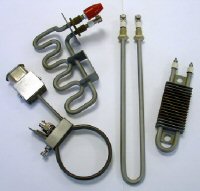| Tubular elements | |
|
|
Introduction |
|
|
Technical description |
|
|
Enquire for a quotation or place an order |
Tubular elements, Introduction |
|
|
|
![]()
 |
Tubular elements are used in many applications for heating up liquids, gases and solids. They can be used for conduction, convection and radiation heating. Our R&D department is available for designing the most appropriate heating element for your application from the early stages of your project. The design of tubular elements enables to manufacture heating element assemblies whose dimensions, shape, wattage and voltage meet your requirements. We can manufacture heating elements from dimensional drawings or samples. |
APPLICATIONS :
The many materials used in the manufacturing of tubular elements make it possible to use them in many different applications whether in the industry or in household equipment :
- Liquids : water, demineralized water, salted water, treated water, glycolized water… for tanks, heating devices, bain marie…
- Gases : Air or inert gases… using forced or natural convection … for electrical air heaters , heater batteries , ovens, drying ovens, grill rooms…
- Solids : Steel, cast-iron, aluminium and bronze for casting, injection presses heating plates, moulds, drawing systems on extruders…
DESIGN :
With quality in mind, we make sure that the heating element we offer is compatible with your application, whether from a thermical point of view – we define specific watt densities for the heating element so that heat transfer is optimum – or from a chemical point of view – we verify that materials used to manufacture the heating element are compatible with your application.
VALIDATION and ADVICE : :
Our help in the design and manufacturing of a heating element does not exempt the customer « integrator » from valildating the heating element with trials and from verifying that it complies with standards.
Here are Watt densities commonly used and that should not be exceeded depending on the application :
Water : 10W/cm² (65 W/in²) Oil : 2.5 W/cm² (165 W/in²)
Air : 4W/cm² (26 W/in²) Frying oil : 5 to 6 W/cm² (32 to 38 W/in²)